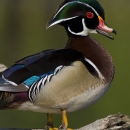Featured Species
Cat Island NWR provides migration stopover and wintering grounds for mallards, green-winged teal, gadwall, and American wigeon. The refuge is an important area for many species of neotropical migratory birds, including the swallow-tailed kite, a species of special concern. Forest breeding birds include red-shouldered and broad-winged hawk, yellow-billed cuckoo, pileated woodpecker, Acadian flycatcher, great-crested flycatcher, yellow-throated and red-eyed vireo, blue-gray gnatcatcher, wood thrush, American redstart, and warblers including the northern parula, prothonotary, yellow-throated warbler, Swainson's, Kentucky and hooded warbler.
The refuges’ bottomland hardwood forests are composed of tree species such as oak, elm, and hickory - species that thrive in lowlands along river systems. Oak and hickory nuts provide a food source for many wildlife species. The refuge is well-known for its abundant squirrel population. These diverse forests are also great habitat for white-tailed deer, waterfowl, crawfish, wading birds, and songbirds.
Because the refuges’ low-lying cypress-tupelo swamps along the river were difficult to log, many large old trees remain, providing great habitat. These mature trees support wading bird nesting colonies, and provide cavities for bats to roost in, and for wood duck, hooded mergansers and prothonotary warblers to nest in. The refuge is used by thousands of wood ducks and is an important breeding ground for this species.



